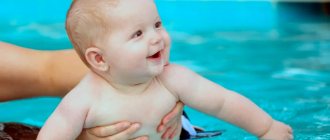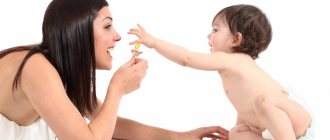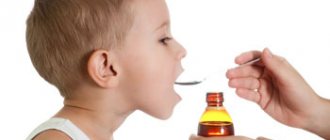Recommendations for carrying out exercise therapy
- Physical therapy begins in the second month of the child, alternating with massage. After six months, exercise therapy is first performed, then massage as a rest.
- A child who is feeling unwell is not given exercise therapy; treatment is first applied.
- Children enjoy massage and exercise. If displeasure is shown, they distract him with a toy, calm him down or pick him up and find out the cause of the baby’s anxiety. You get used to the rhythm of classes gradually, and the least favorite exercise is performed at the very end of the procedure with a minimum number of repetitions.
- You should not be overzealous, since the baby will remember the discomfort and pain for a long time, and will cry even before the start of exercise therapy and massage. During massage, hyperemia should be uniform, red spots and bruises should be absent.
- A complex procedure of exercise therapy and massage is carried out 0.5-2 hours after bathing and eating, in a bright and ventilated room with no drafts and at a temperature of 20-22˚C, on a changing table with a free approach from three sides.
- Before the procedure, wash your hands thoroughly and warm them up, remove all metal objects (bracelets, rings, watches) to prevent damage to the baby’s skin. There should be no abrasions or wounds on the hands, and nails on the fingers. Rough hands are generously lubricated with baby oil.
- Try not to use ointments and creams for massage. Although this issue remains controversial to this day.
- During a massage, only those parts of the body that are being massaged are exposed to a child up to a month old; after a month, the child is left naked. For exercise therapy, the baby wears a T-shirt with short sleeves, a T-shirt, and panties with diapers.
Basic rules for morning exercises for children
There are general rules that are always followed, regardless of age:
- exercises are done on an empty stomach, and to help the body wake up, you can first wash your face and drink a glass of water;
- the room should be well ventilated, it is even better to practice directly in the fresh air;
- most of the complex should consist of warm-up and stretching, and strength exercises should be avoided;
- watch your breathing: there should be no delays, there should be a rhythmic cycle of inhalation (through the nose) and exhalation (through the mouth).
- Hardening procedures (contrast shower or washing with cold water) and a healthy breakfast will help to consolidate the positive result.
In childhood, it is especially important that activities are interesting. Therefore, choose cheerful, upbeat music and change the exercises for children from time to time: add new movements, complicate them, come up with funny names for the exercises.
A set of exercises on the ball
An assistant will be needed to carry out the exercises. All exercises are repeated 10 times.
- Place the child on an inflatable ball covered with a diaper on his stomach, bending his legs “frog” and pressing them to the ball. The assistant needs to hold the child’s legs, the instructor needs to pull the baby by the hands (or put the index fingers into fists) towards himself and return to the starting position.
- The child lies with his stomach on the ball, the assistant presses the baby's straight fingers to the ball. The instructor pulls him by the shins and brings him back.
- The assistant holds the baby in the same starting position with his fingers pressed to the ball, the instructor tries to turn the child on the ball and place his feet in the center of the table, straightening his curled fingers. You need to fix the position for 1-3 seconds and return the ball back.
- The assistant holds the child as in exercise 1, the instructor pulls the ball by the hands and placing open palms in the center of the table surface. You need to make sure your baby doesn’t hit his forehead on the table!
- Place the child on the ball with his back and, holding his sides, rock him in the direction of 4 sides to relax the muscles.
- This exercise is performed when the child arches (increased muscle tone) to the right or left in a position on his stomach or back. The child is placed on the ball sideways: right - when bending to the right, left - when bending to the left. Perform smooth rocking of the ball along the axis of the body. The baby will relax, which will make the subsequent massage easier.
Fourth month
Gymnastics for a 4 month old child repeats the set of previous exercises. What is especially useful for children at this age and what do they perceive with delight?
- Exercise for legs. At this age, the baby begins to perceive all the actions of adults as a game. The “bicycle” exercise will be interesting for the baby. Children also love to “applaud” with their feet. To do this, you need to attach the child’s feet to each other and slam them. You can put your legs in the “frog” position and rock the baby, reach your nose with your toes, etc. You can also stretch in this way: you need to pull your right arm and left leg towards each other, then change the arm and leg.
- Hand charger. The “okay” exercise develops fine motor skills well and brings a lot of positive emotions. You can perform cross movements with your arms in the form of hugs, “boxing”, “swimming” - all those exercises that were performed in the first months of life.
- Exercises for the abs. Children of this age are already trying to do pull-ups with their hands if you place your thumbs in their palms. During the day, you can arrange lifts for your baby several times that will train the abdominal muscles, as well as the back, arms and neck.
At this age, all movements become more energetic and intense. The child gradually turns from a passive observer into an active participant in the process.
Exercise therapy for baby's legs
The child is placed on his back and the exercises are repeated 10 times.
Exercise 1. The baby’s legs are bent at the joints: knee and hip, closed, bringing the knees closer together. The thumb holds the knee, the rest clasps its pelvis, and the pelvis is rotated to the sides.
Exercise 2. The baby’s legs are straightened and bent alternately, then the right arm and left leg, the left arm and right leg.
Exercise 3. Spread the legs at the hip joint. Do not forget that the effort to overcome the baby’s resistance should be minimal, since children do not like this exercise. If you have hip dysplasia, only your orthopedic surgeon can allow you to perform this exercise.
Correct visual habits
What useful habit should you develop and be sure to instill in your children?
Under no circumstances should you bend low when you read and write!
Each person has his own distance from the eyes to the writing surface. This is the “chamon distance” - from the elbow to the tip of the fingers that touch the temporal region. This is the ideal eye distance. As soon as you start to bend over, your muscle is overloaded. Moreover, the rate of load on this muscle increases exponentially.
When I teach “school of insight” classes, I always give the children this example: when you sit correctly, it’s the same as if you’re just walking down the street. But if you bend over even a little, it’s the same as if they put 50 kg on your shoulders, that is, a sack of potatoes. This is the load our ciliary muscle experiences.
So, in no case, under any circumstances, bend low when reading or writing. This is a basic visual habit!
If you are sitting at a computer, at a phone, at a tablet, at any gadget, please hang some picture somewhere away. It should be quite small, but you should be able to see it clearly.
For example, it could be a calendar with numbers and you should see them, or any emotional picture that you want to look at. Every 15-20 minutes of close-up work, you glance at this picture for 5-10 seconds.
Thus, if you study for an hour, read, write, sit at the computer, you should look into the distance 4 times and palm 2 times. These are real visual habits.
When I ask, “When do you do eye exercises,” most people answer that when they are sick and tired.
This is not entirely correct! You must be one step ahead, that is, not let them get tired.
Teaching a child to sit down
After 4 months of age, the child is taught to master sitting down, squatting and bending, holding a stick, and standing on all fours. Repeat the exercises 10 times.
Sitting down. The baby lies on his back with his arms extended along his body. The assistant needs to press his right palm to the table next to the body. The instructor should hold the baby by the straight legs, with the other hand, lift him up by the back and force him to sit down, leaning on his right arm, slightly bent at the elbow, and slightly tilting his torso to the right. Then the handles are changed and everyone starts over.
Sitting down with a stick. While lying on his back, the child is given a stick with a diameter of 2-3 cm in his hands and his fists are held so that he cannot let go of it, at the same time he is forced to lift his back from the surface and sit down. The assistant needs to fix the straight legs and make sure that the child does not hit the back of his head on the table.
Squat on a stick. The stick is placed on the table surface under a folded diaper. The baby is held under the arms and the legs are placed shoulder-width apart on the midsole stick. When performing squats, make sure that your feet do not move.
Tilts on a stick. Fixing the feet, as in the previous exercise. Hold the baby's straight legs in front with your left hand, fix them under the chest and stomach with your right hand, then tilt the baby's torso.
Stand on all fours. The baby lies on his stomach, the instructor’s hand is under his chest, with the other hand he bends the legs at the hip and knee joints. At this time, the assistant needs to press his outstretched palms to the surface at the width of the baby’s shoulders. He is allowed to fix the pose for 1 minute, which does not work the first time.
Crawling on all fours. Performed at 6 months or when able to stand on all fours.
It is performed according to the above method of teaching crawling on your stomach.
Gymnastics for newborns from the first days of life
Hello, my dear readers! Today we’ll talk about what is an important daily part in the life of mother and baby - gymnastics for newborns from the first days of life. It’s probably worth saying right away that I will not promote advanced methods such as dynamic gymnastics or ball gymnastics
We will talk about a regular warm-up, which certainly will not harm the fragile body of a newborn. First, let me explain what dynamic gymnastics is. This kind of gymnastics differs from the usual one in a large number of movements and in that the child does not lie down, but is in the arms of an adult, hanging either from his arms or from his legs. There is a lot of controversy regarding the benefits of this method, so I will not definitely recommend or criticize it. I can only say that if you decide to resort to such exercises, then you should consult with a pediatrician and pediatric surgeon.
What you should know before you start gymnastics for newborns from the first days of life
- Gymnastics should be daily!
- Gymnastics for newborns from the first days of life is one of the important points in caring for a baby, so this process should not cause bad associations in the child, and for this it is worth performing it exclusively at a time when the child is in a good mood and he is relaxed. If the baby is restless in the morning after waking up, there is no need to force him with physical activity.
- Since any physical exercise is invigorating, there is no need to do it before bed.
- You need to start charging about an hour after eating. Otherwise, you will harm digestion and the baby will spit up a lot.
- Gymnastics should be performed on a flat, preferably hard, surface. A changing table covered with a diaper or a changing board that you purchased along with other items for your newborn will work well.
- If the baby does not respond to any exercises, it should not be done by force. Otherwise, you will end up doing more harm than good.
- In addition to exercise, the child also needs a massage. A light massage should be given to the baby before physical exercise to prepare the muscles, and after to relax.
- It is better to perform massage using baby cream or any other product from your first aid kit for a newborn that you use to care for your baby’s skin.
- The duration of massage and gymnastics for newborns from the first days of life should be no more than 5 minutes. By about three months of age, the duration can be increased to 10-15 minutes, gradually increasing the number of repetitions of each movement from 5 to 15 times (read also the article on how to develop a child at 2 months).
- When the child is unwell, you should wait a while with charging.
If you think that such light gymnastics is not enough for your baby, don’t worry, because during the day the child actively waves his arms and legs, moreover, bathing the baby is also a physical activity, during which the child trains and strengthens all his muscles, not to mention about the benefits of bathing a newborn with a circle. And in general, if the child’s mood allows, you can do exercises several times a day! And even do exercises on a fitball for newborns!
Strengthening the vestibular system with rotation
Exercise strengthens the autonomic nervous system and vestibular apparatus. A folded diaper is placed on the “Grace” or “Health” disc and a metal basin is placed on it. The size of the basin is selected so as to lay out a blanket and place the child there in a reclining position. Slowly and smoothly, without jolts, rotate the basin for half a minute. When stopping, the baby's eyeballs should oscillate horizontally. This nystagmus occurs when looking at stationary objects or surroundings from a rotating or moving cabin. As soon as the eyeballs stop moving, the basin is rotated in the other direction. Gradually the movement time increases to 5 minutes.
Benefits of reflex exercises
Reflex exercises help strengthen the muscles of the neck and torso and are used for movements that occur as unconditioned motor reflexes. When the receptors of the muscles, nervous system and skin are irritated, innate motor reflex reactions appear: tilting the head back in a suspended position, bending the entire body and forming an open arch. This movement is an energetic stimulus that strengthens the vestibular apparatus. Therefore, from the age of 4 months, you need to hold the baby more often in a position on his back or on his stomach to strengthen the muscles of the neck and torso. In the future, you can use signal stimuli in the form of sound signals, pulling the legs, grabbing, etc., to create conditioned connections based on innate reflexes.
Why do you need dynamic gymnastics?
DG is a technique that is an effective tool for solving a wide range of problems directly related to the physical development of a child.
Pathologies that dynamic gymnastics helps correct:
- asymmetry;
- muscle hypotonicity;
- hypertonicity;
- clubfoot;
- torticollis.
A number of exercises are aimed at activating the functional activity of the intestines, helping with frequent constipation and flatulence.
Important: we can say with confidence that dynamic gymnastics is applicable in all areas where massage helps, and is in no way inferior to it in effectiveness. At the same time, it is designed not for specialists, but for parents
All exercises are easy to learn and can be practiced daily at home.
Dynamic gymnastics is characterized by versatility from the point of view of the general development of a small child. During the classes, not only bones and muscles are strengthened, but also a positive effect is exerted on all organs and systems of the baby. His vestibular apparatus improves, and improved coordination of movements has a beneficial effect on the psyche. In addition, he begins to navigate space faster and better.
DG plays an important role in the prevention of childhood injuries. A baby who regularly performs a set of exercises with his parents has a much better reaction and stronger joints. He confidently controls his body in potentially dangerous situations.
Please note: there is an opinion that DG to a certain extent compensates for the lack of so-called
“birth experience” in children born by caesarean section.
Gymnastics goes well with hardening. When performing the complex, it is recommended to completely remove the child from clothing. When exercising outdoors, an important factor such as insolation is added to the physical impact. The time spent in the cold can be gradually increased, which will help the body adapt to temperature factors and strengthen the immune system.
Undoubtedly, dynamic gymnastics promotes the development of the cardiovascular system.
During the implementation of the DG complex, the nervous system of a small child receives a huge number of different signals, which contributes to its development as a whole. The baby's motor reflexes are regularly stimulated, and reactions to external factors are constantly being trained.
DH is an excellent opportunity to establish trusting relationships between a newborn and others.
Please note: exercise can promote nervous relaxation, which is important for hyperactive children. A well-chosen complex, on the contrary, will help to activate an overly lethargic baby.
All parents who practice dynamic gymnastics with their children note that they very rarely get sick, sleep soundly, have an excellent appetite and are almost never capricious.
All parents who practice dynamic gymnastics with their children note that they very rarely get sick, sleep soundly, have an excellent appetite and are almost never capricious.
Despite the enormous possibilities, dynamic gymnastics should not be considered as a self-sufficient system. It goes well with active and passive massage, hardening and exercises in the pool (aqua training). Any active work with the baby can always be carried out in parallel; It is only advisable to shift the emphasis in one direction or another depending on the individual characteristics of your child.
The dynamic gymnastics complex includes:
- massage;
- hardening procedures;
- exercises in the air;
- Exercises with a large diameter ball.
It is important to combine all types of activities for a comprehensive and most effective effect on the body.











